Jinbao-made bass sax
Stencil name: Sakkusu, but Jinbao stencils bass saxophones for anyone who orders them including, but not limited to: Thomann, International Woodwind, Wessex, Music Medic (Wilmington), STAGG, etc. etc. For a more complete list, check out the Jinbao page on Bassic Sax.
Price: Current price of Sakkusu is $4493 US. However, prices vary widely depending on ordering company. On August 28, 2023 I found the following the price spread: $3300 to north of $15,000 US, for a wide variety of stencil names. (Jury is still out on who manufacturers the P. Mauriat bass. More on that some other time.)
Date of manufacturing: circa 2018
Date of review: 2023
How I got here, and the burning question I had
A few weeks ago I had the opportunity to start playing in a saxophone ensemble for the first time in over 20 years. The leader of the group also has his own bass sax. I was excited for a couple of reasons: 1. I got to meet another bass saxophone player/owner who lives locally, and 2. Rob’s bass is not like any bass I’ve played before.
Rob’s bass sax is a modern Selmer copy made by Jinbao. Finally I would be able to playtest one of these horns, and write a review similar to what I did with the Jinyin-made, vintage American style modern bass.
I have been asked so many questions over the years about French wrap, AKA short wrap, bass saxophones in general—and Jinbao-made horns specifically—that I have never been able to answer with any real authority. Additionally, there are also all these opinions and comments about short vs long wrap horns floating around, I really wanted to try one for myself.
Beyond the basic review of a Jinbao-made bass stencil, I had one overarching question: Do French wrap horns, due to their design, inherently sound different than long wrap horns? Do they really sound like uber baritones?  This is of course a criticism that has been leveled against them for as many years as people having been writing stuff on the Internet.
This is of course a criticism that has been leveled against them for as many years as people having been writing stuff on the Internet. 
This past weekend Rob came over and we spent about 5 hours together. He tried various pieces of my bass gear, and I tried his. I also took all the horn pics in my too-crowded a studio, that is yes, lacking in proper studio lighting, while he patiently waited. Thanks Rob, you were incredibly patient and kind.
Specs
- Tuned in the key of Bb – one octave below a Bb tenor.
- Keyed from low Bb to high F#
- Lacquer finish with hand engraving.
- Ribbed construction.
- Leather pads with domed metal resos with rivet.
- Weight 20 lbs (according to my scale, but YMMVALW)
- Adjustable, black plastic, right thumb rest. (Way too flimsy for my liking. See point 4 under What I didn’t’ like.)
- Triple strap ring.
- Metal peg with rubber foot to avoid having to wear this piglet around your neck.
- Lightweight, zippered case with wheels for transport.
- Copy of current production model: Selmer Super Action 80 Series II Bass Saxophone
- Came with Yamaha bari mouthpiece that has NOT been modified for bass saxophone.
- Rob estimates approx. this instrument has about 600 – 700 hours of total playing time on it so far.
Set-ups Used for the playtest and how they rated
I tried a variety of bass and modified baritone saxophone mouthpieces on this Sakkusu bass saxophone to see what worked, and what didn’t. I was surprised to find that they all worked. Just some worked better than others.
 Geo Bundy bari/bass #3
Geo Bundy bari/bass #3
This vintage hard rubber bari/bass MP by Geo Bundy is stamped with a 3. (Shown here with a Conn Eagle bari/bass MP.) Truth be told, although I got it for my Buescher bass, I never used it with the True Tone. I have never been overly impressed by what it can do when compared to my modified bari pieces. That said, I had never tried it with a short wrap bass. Wow, was I surprised!
The vintage Geo Bundy MP was far and away the easiest playing, and nicest sounding MP of the bunch. (Remember again, that I had in total only approx. an hour of playing on the horn. Had I had more, perhaps the Vandoren would have moved up to first place.)
This Geo Bundy MP would be what lots of players call darker—meaning it allows more of the core tone to come out. Very few overtones were present when compared to any of the other MPs that I tried out on the Sakkusu bass sax. For ease of play alone it would get the #1 spot on the list.
Although not the sound I am personally looking for, this ease of play when combined with the tone produced—and spot-on intonation that happens in combo with this modern horn—assured this Geo Bundy the #1 spot on the MP list.
 Vandoren V5 bass sax MP
Vandoren V5 bass sax MP
This is the mouthpiece that I actually conducted the majority of the playtest on. It was a great MP for this Chinese-made Selmer knock-off. It played evenly across the entire range of the instrument.
It had a few more overtones than the vintage hard rubber Geo Bundy bass/bari I got for my Buescher True Tone. However, it had less overtones than the modified Runyon bari piece I always use. This Vandoren was nonetheless a good fit for the horn given the length of time I had to playtest the instrument.
Had I had more time on the Sakkusu bass, this Vandoren may well have become my #1 choice, but I didn’t have time to learn the nuances of it. I suspect it is capable of more than the Bundy, which is why it is more difficult to play at the outset.
#2 overall for ease of play and tone, I would say this is a fine MP for these Jinbao-made bass saxophones that are patterned after the Selmer Super Action 80 Series II bass.
 Runyon #5 blank
Runyon #5 blank
This is my primary bass saxophone MP. (Shown here together with the Geo Bundy mentioned above.) It was customized specifically for bass saxophones the same way Santy Runyon did for the great bass players back in the day.
How is it customized? As described in detail by Paul Coats himself on my website, the usual baritone MP facing of 24mm – 25mm has to be lengthened to about 29mm – 30mm. This allows for more of the reed to vibrate freely, and the bottom end of the horn to speak properly.
Overall I would rate this MP as fair to OK for this Jinbao-made bass. It allowed for lots of overtones—the most of any of the 4 MPs I tried out. However, it made the bass a bit harder to control in the tricky middle range, and especially over the break (C2-D2).
The horn tended to break a lot with this modified bari piece, and it was very easy to crack notes. If I had been able to spend more time playing the horn, I would likely rate this MP as good. But given the time restraints I had, I could only rate this MP as #3 overall.
 SELMER S80 C* BASS SAX MP
SELMER S80 C* BASS SAX MP
This is the only MP I tried on the horn that wasn’t mine. When Rob bought the sax from sax.co.uk, it was one of the recommended upgrades that the shop suggested. (Remember it came stock with an unmodified Yamaha bari piece.)
This is at present Rob’s primary bass sax MP, but as you can tell by its 4th place yellow ribbon, it was my least favourite.
Overall it was similar to the Vandoren with regards to the overtones it brought out in the horn. However, that is about all it had in common with the Vandoren in the brief time I played it. The S80 was not nearly nearly as easy to control over the break. It tended to break and crack notes even more over the break than the modified Runyon baritone piece did.
I found that the piece felt too closed for me. In short, I would not want to use this piece. Even when I tried it on my Couf, my easy-going JK turned more into a more difficult horn to play.
 Reed
Reed
Harry Hartmann M Onyx baritone Fiberreed
I used the same reed throughout the entire playtest to keep things consistent. The reed I used is currently one of a few bari reeds I use in rotation on my Superba I bass.
Tone
After nearly 15 years of hearing that French wrap, AKA short wrap, bass saxophones were nothing more than uber baris, or baris on steroids, I had no idea what I was going to experience when I first tried Rob’s Jinbao-made bass saxophone. Was this going to sound like my my Mark VI bari? Was it going to sound like my Couf bari? Was it going to sound like me playing any bari at all? Or was it going to sound like me on a bass sax?
Guess what? From the first notes I played, I sounded just like myself playing bass saxophone. Period. Full stop. (More on this below when the Sakkusu is played head to head with my Couf.)
- I am not a timid player on any horn, and bass sax is no exception. I play bass sax like I mean it: Assertively; with volume; and with lots of support for that dreaded going over the break.
- The various mouthpieces I tried on the horn all played well on this Selmer Series II knock-off. Some did however, play better than others. (See set ups section for full break down.)
- Since I am not familiar with this bass in particular, or even this style of bass in general, I was totally shocked when I was no more than 20 cents sharp over the entire range of the horn (low Bb to high F#).
Overall, I was very impressed with the variety of tones available on the Sakkusu bass. I love overtones, and this Jinbao-made Selmer knockoff certainly has lots of them. However, for players who are more into the core tone of an instrument, the right MP can bring out a very lovely and pleasing tone that would be suitable for everything from classical to concert band, to sax ensemble playing.
Response
This Jinbao-made bass saxophone was quick, and easy-blowing. I was pleasantly surprised at how even its scale actually was. Was it perfect? Not entirely, but then we are not talking about a Selmer Paris horn made by master craftsmen here. (BTW, Selmer currently lists the Series II bass at $35,468.47 US on their website. Apples, meet oranges.)
There are two warm-up exercises I always do after I’ve done my long tones. I do these regardless of which saxophone I’m playing, and what voice of sax it is.
1. Going Over the Break
Here you tongue the G and slur to then end of phrase. Then tongue the first G again. You start out slowly, and keep going faster and faster, making sure your air is supported, and you don’t crack your D2.
2. Pivot on the Break
Here again you start out slowly, and build up your speed until you are lightning quick.
How did the Sakkusu bass do on these exercises?
With the Geo Bundy MP I was able to do both of these exercises with absolutely no difficulties on the Jinbao-made horn. I was easily playing them as quickly and cleaning I do on my Mark VI baritone or tenor.
For music, I tried Saxophobia, which I have been working on my Couf bass. With the Jinbao-made Sakkusu bass I was able to play Rudy Wiedoeft’s famous piece better, cleaner, and far easier than on my Keilwerth. And yes, it hurts to have to write this. 
Feel
Ergonomically the horn was quite comfortable, although there were some peculiarities that I was not all that fond of. Most notable among these, is the location of the high F# key.
- The high F# key is placed in such a way that it is difficult to locate. It’s like the designers thought: Oh, we were going to add a high F# key to this horn. Damn, we’ve used up all the available space. Let’s just put it here. No one uses high F# on a bass anyway.
- Because it is so low, and positioned where it is, it is difficult to reach fluidly—and not at all intuitively, even if you know that it is there.
Another thing I wasn’t all that fond of is the overall squishiness one feels in the keys. There is a quite a bit of give in the long rods and hinge tubes, which leads to the overall more sloppy feel of the instrument.
- Since I didn’t take Rob’s bass apart, 😉 nor am I a tech, I am not clear why the horn is so sloppy. I would be curious to talk to a tech who has worked on one in the past. My guess is that Jinbao cut some corners when making this horn on the cheap like this. Some parts are just too weak, long, not supported enough, or whatever.
Going along with the feel, is the size of the pearls. They, together with their keys, simply feel too small for a horn of this size.
- Yes, I am very spoiled by Keilwerth’s oversized pearls that are shaped to allow your fingers to comfortably rest in them. But even if I wasn’t spoiled by my own bass, the pearls—and I use this term loosely, since they are made of plastic—on this Sukkusa bass just feel wrong for a horn of this size. They feel more like they belong on an alto, rather than on a bass sax.
- I am very fond however, of the spatula front F, as well as the horizontal laying oval bis Bb key. Not sure why the rest of the keys got short-changed.
Bottom line: It is hard to pin down and put into words, but this bass just didn’t feel like a pro horn, when compared to say my Couf. But then the Sakkusu is a bass that sells for pennies on the dollar of what a Keilwerth or Selmer would cost, so this shouldn’t come as a surprise to anyone.
Build
Let me start with the standard disclaimer I always provide when I do reviews such as this:
I am not a tech, nor do I play one on TV. 
When I first lifted this Jinbao-made bass out of its stand I was shocked at how heavy it was. I know Buescher stated that their True Tones were 18 lbs. The Sakkusu felt like it weighed more than that.
I decided to get one of our bathroom scales and put this Sakkusu on it, and it weighed in at 20 lbs. I was surprised by this, and wondered what design features/materials may be contributing towards this extra weight.
Factors contributing to weight
A closer look soon answered the question of what contributes to the horn’s weight:
- It has ribbed construction (pic below), and some extra bits of metal that the Buescher True Tone did not have.
Additionally the Sakkusu used extra metal for features such as:
- The two peg holders.
- The connecting rings. There are 7 in total over the entire instrument, along with their various attachment bits like screws, bolts, and decorative what exactly ❓ that sits opposite the screws.
- A mystery connection by the lyre holder, which it looks like they copied it from Selmer. Wonder what it’s for?
- Two bell to body braces. One located at the top 1/3 of the bell, and the 2nd on the left side, lower portion of the bell, just above the bow.
- A brace that separates the main body tube from the pigtail.
NB: I didn’t notice it at the time, but in the photo above, take look at the soldering on the tone hole, and the post beside it.
I would love it if Steven Howard were to sometime review one of these Jinbao-made bass saxes from a tech’s perspective like he did with a Jinyin horn. What do you say Steve? I bet you are going to find some interesting stuff. 😉
What I didn’t like
There are some things in the build that are rather off-putting for me about this Sakkusu bass:
- The left thumb rest is too low. This leads to awkwardness when trying to operate the octave lever. If it were my horn, I would build up the left thumb rest to make it more ergonomically friendly and comfortable to operate the octave key.
- There is lots of loose key movement (up and down) on a number of the long rods and hinge tubes.
- The left palm keys feel weak and thin. There is too much movement in these. They almost feel like they could snap if too much pressure is applied to them.
- The right thumb rest is too thin and cheap. I would replace it with a Selmer one if it were my horn.
What I liked
However, there was also stuff I really liked about about this Sakkusu bass:
- Loved the metal peg with its rubber foot. It is secure, and once the peg is in there, it holds the bass perfectly in place. The sax can be stored in its case with the peg attached fully retracted. This is a very nice feature. (I wish my Couf had it.)
- The triple strap ring is nice. Although when I played it, the middle opening was the best for me, others may prefer the bass balancing at a different angle.
- Really liked the range. Low Bb to high F# without using altissimo is a real treat.
- Having a bis Bb is also very fine.
The photos of the Sakkusu bass saxophone made by Jinbao
Head to head with my Couf bass
I could not tell the difference when I played my Couf Superba I bass with my regular Runyon bari MP specially modified for bass, with a bari sax reed, and the Sakkusu bass with the same MP/reed set up. The two bass saxes sounded the same.
My friend, and owner of the Sakkusu, who was sitting in the room with me during the playtest, said I sounded like myself on his bass sax. He too could not tell the difference.
I still wasn’t satisfied. I wanted a totally impartial ear to hear whether or not French wrap bass saxes were more like uber baris, or whether they sounded like a true bass sax. In order to do that, I asked my partner to come downstairs and do a blind listen test. My partner has listened to my bass playing for 23 years, so is very qualified to pick out my sound.
I played both saxes back to back and asked: So, which is which? Can you tell? Was there a difference?
My partner did guess correctly. The Couf was ID’d as the first horn I played. Why? Not because of the tone or sound. According to my partner, those features on both horns was the same. The reason for correctly being able to ID my Couf was simple: Because it took more air, and I had to breath more often, which is what my bass playing normally sounds like.
What do they sound like when played together?
Now, because I am totally anal, and wanted to hear for myself what things sounded like, I decided to record Rob and I playing a duet in unison. I opted for the head of the Pink Panther, since everyone knows what that sounds like.
Here is what happened:
- We practiced it at most 5 times together, and that was it.
- I recorded it on my iPhone 13.
- I chose not to add any reverb or effects on purpose so what you would hear would be a dry sound.
- 2 bass saxophones are playing here:
- Helen: Couf Superba I. Modified Runyon bari MP. M Onyx Fiberreed.
- Rob: Sakkusu bass. Selmer C* bass MP. Légère 3 bass reed.
Pink Panther bass sax duet in unison
So in conclusion then…
These Jinbao-made Selmer Super Action 80 Series II knockoffs are just that: knockoffs.
While sure, these Jinbao basses may be better constructed than those junky Jinyin horns we saw years ago that were styled like vintage American horns—they certainly play better—they are still horns that are manufactured in China, which (for the most part) cost less than 1/3 of what the Selmers they are copies of, do. It really is a case of apples vs. oranges.
Don’t believe me? This is the review of Jim who works at sax.co.uk of this same model bass saxophone:
What an absolute bargain this is! At the top end of the bass sax range you have the likes of Selmer, Epplesheim and Keilwerth and generally speaking you have to part with the best part of 20 Grand to buy one – for the majority of interested parties, this is too expensive! On the budget side of things we have come across a few specimens where the quality has been suspect and the ability to play the sax with any kind of smoothness has been severely compromised – to our joy, this new model is coming in even cheaper and with quality that vastly outstrips anything we’ve seen in the past! The mechanism is solid and secure, the key positioning feels very natural for a bass sax and the quality of the brass itself is good – pretty important when you are dealing with such a large mass! Having experimented with a few mouthpiece set-ups, I found the best combination was a Selmer S80 Bass mouthpiece with a number 2 Vandoren Bass reed. The response down at the bottom was superb and the sound was very fluid as I ran up to the top of the range. Considering the price is so good I think we might see a handful of extra bass sax players up and down the country!
Jim
Jim is pretty honest about these Sakkusu not being on par with the Selmer, Keilwerth, or Eppelsheim bass saxophones. You can’t pay less than 1/3 of what you would spend on a pro horn and ask it to be built the same. That said, these Jinbao-made horns do still have a place in the saxophone world.
Who are these Jinbao-made horns good for?
For a weekend player, or someone who doubles on bass occasionally, these horns may well suit that player well. If however, you are primarily a bass sax player, and/or earn your living from playing bass saxophone almost exclusively, I suspect these horns are simply not going to stand the test of time.
Much like the Jinyin-made, long wrap bass saxophones previously reviewed, depending on which stencil name is on the horn, your Jinbao horn may benefit from a visit to your tech’s shop for some fixes and upgrades to make it more durable.
I say depending on which stencil name is on your horn, because it is quite possible that different ordering companies ask for different features from Jinbao, or customize the horns when they arrive in their shops. (For example, Music Medic does stuff to their Wilmington bass saxes that other companies don’t.)
I am seriously picky when it comes to my own personal horns, and what I demand of them in the long haul. I also understand that not everyone looks at things the same way I do, or demands the same thing from their instruments. For that reason, when taken in its totality, I would give this Sakkusu bass a 7 out of 10 for all the reasons I have outlined above.
I would like to end this review with a list of both the Pros and Cons of this Jinbao-stencilled Sakkusu bass. It is something people have asked me for, for years, so I hope it gives you a starting point at least if you are considering a purchase of one.
Pros
- Sounds like a bass saxophone. Wrap length doesn’t matter.
- More compact, thus easier to transport than long wrap versions.
- Intonation easily will be spot on—at least on the bass I tried—once a player becomes familiar with the instrument.
- Great tone, with plenty of overtones. Very pleasing core tone.
- Overall the tone is very malleable, and depending on the MP set-up used, can be adapted to player’s needs/wants.
- Easy-blowing, with quick response over the horn’s entire range.
- Requires less air than my JK bass, and certainly less air than any vintage long wrap bass I have tried.
- Very MP compatible. Both vintage and modern MPs played equally well. Modified baritone MPs work well too. It all depends on the a player’s tonal preference and the tone that they will personally produce from the bass (source of tone).
- The case that comes with it is practical, and similar to what Selmer includes with their current bass.
- I really like the peg. If I had one on my bass, I would use it all the time. (I have tried some aftermarket ones, but none of them worked particularly well.)
Cons
- Ergonomically not nearly as well laid out as it could be.
- Feels spongy in the keys.
- Appears to have some soldering issues that could prove problematic down the road.
- The octave lever key is too high in relation to the left thumb rest. The thumb rest needs to be built up.
- The right thumb rest is cheap and flimsy. It together with the left thumb rest, are integral to being able to move the instrument comfortably and easily. Selmer has perfected these two rests. Not sure why Jinbao didn’t copy them, since they copied the rest of the horn.
- The feel of the plastic key touches was not very pleasant. I know real MOP or abalone is expensive, but how about some more expensive faux MOP? Given the number of hours players spend with their fingers on their saxophone’s keys, that would be something to consider.
- While on the topic of the keys, making the keys larger so that they are relative to the size of the horn would be a good thing.


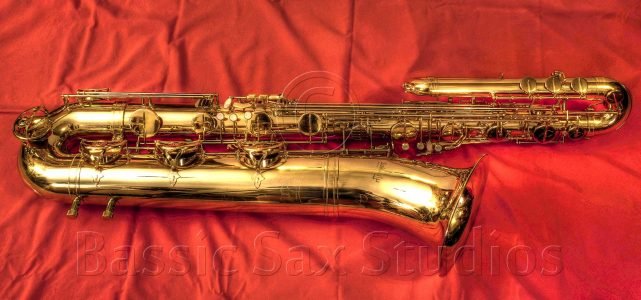
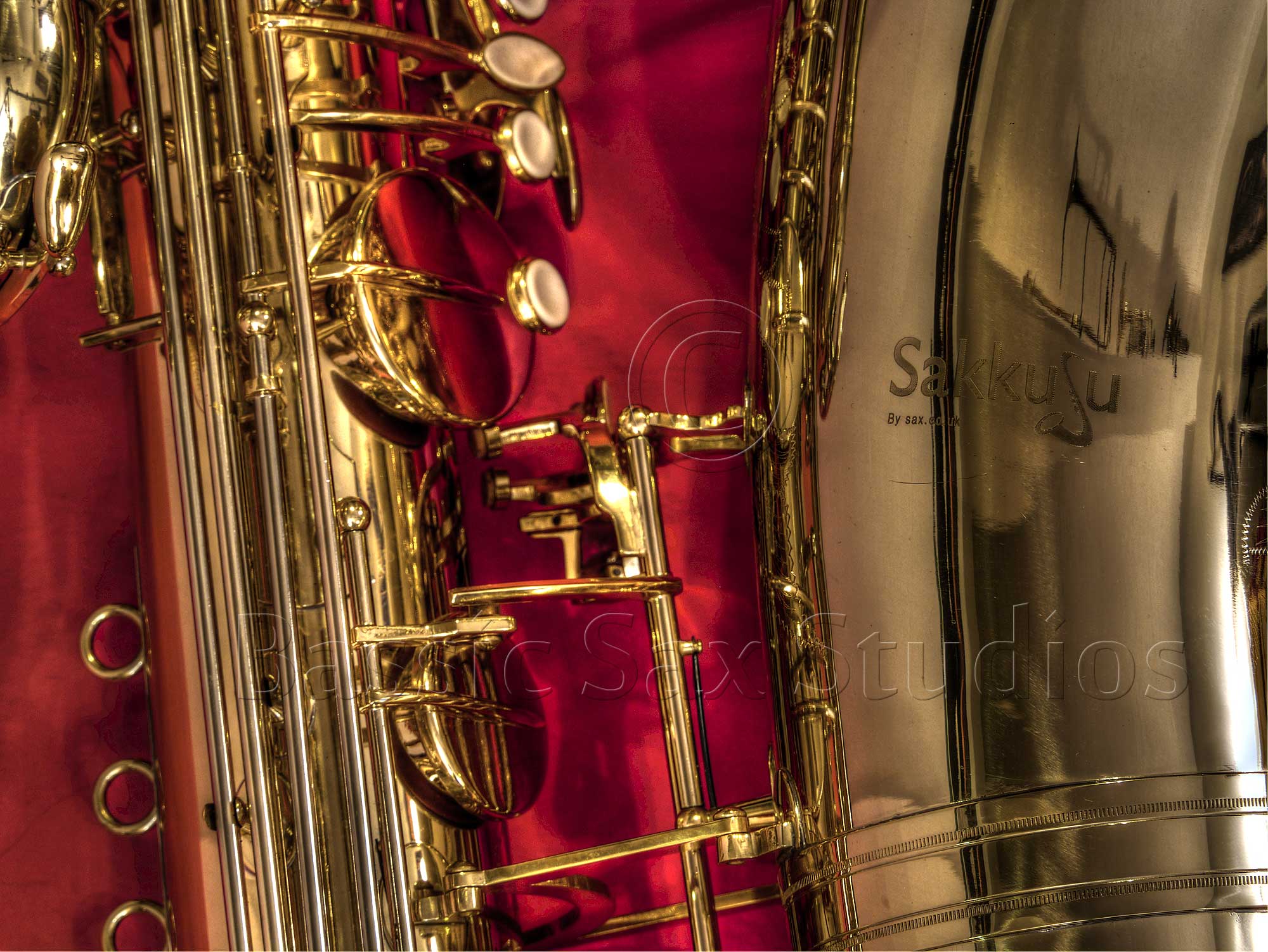
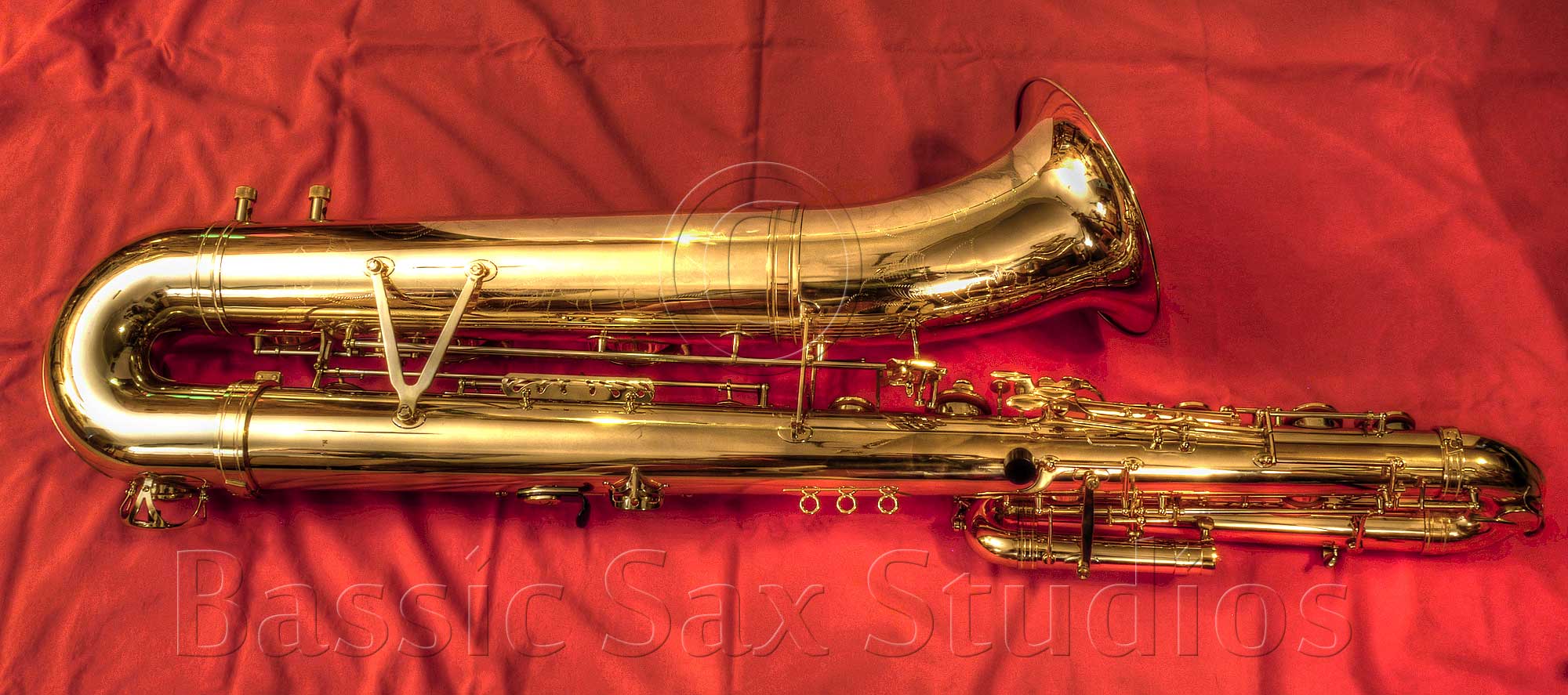
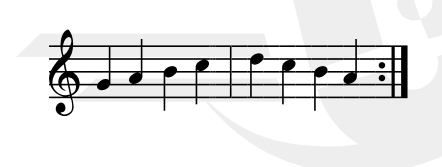




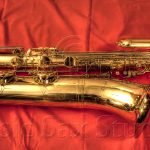
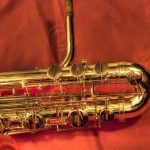
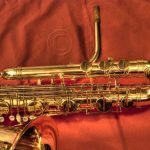
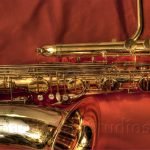


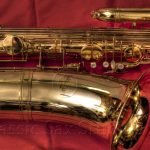


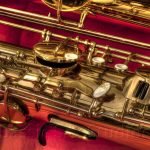

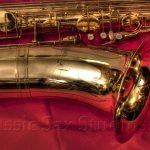
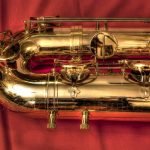
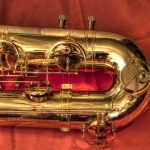
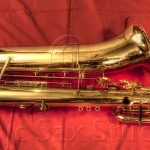
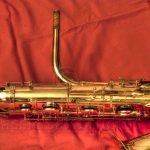

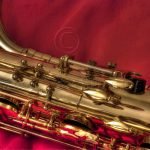
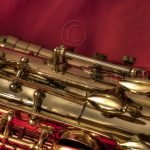
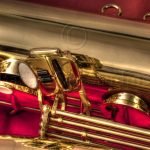


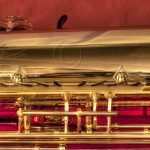
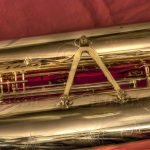
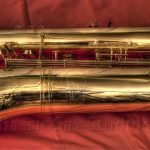
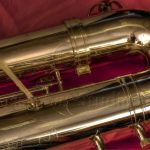

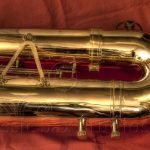
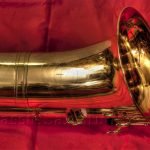
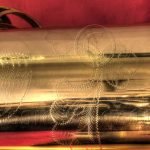
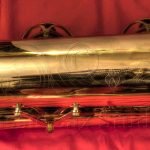


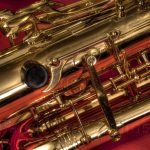
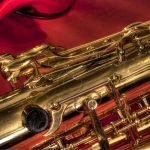
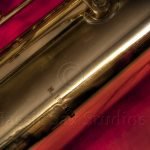
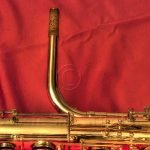
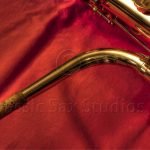


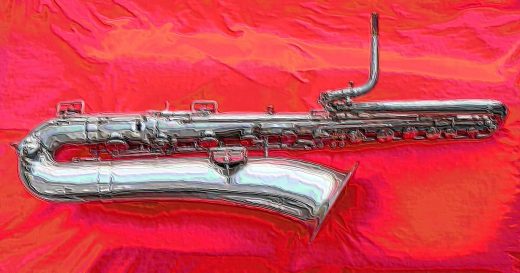
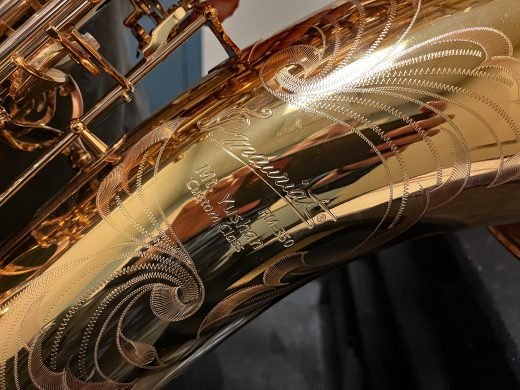
Nice review. I’ve been gigging on mine now for about a year, ~ 20, and rehearsing 2-3 hours per week and haven’t had any mechanical issues.
I tried all the same mouthpieces as you, but rank them in the opposite order. Selmer has the fullest tone according to my taste, and the Geo Bundy, the dullest, with the Vandoren similarly blah. I much prefer cane to synthetic on bass, the latter being too buzzy for my taste. But I can understand the appeal.
As a pretty big guy with large hands, the ergos are just about perfect for me, far better than on my Noblet bass.
I agree this short wrap horn sounds just as good as any long wrap I’ve heard. I’m very happy with it, considering the price.
The peg is a life safer. I even made myself a longer one for standing.
I’ll add that the massive coffin-like case became too much for me to lug up and down a couple of flights of stairs for my weekly rehearsals, so I opted for a gig bag which is much more manageable, if I’m careful with it.